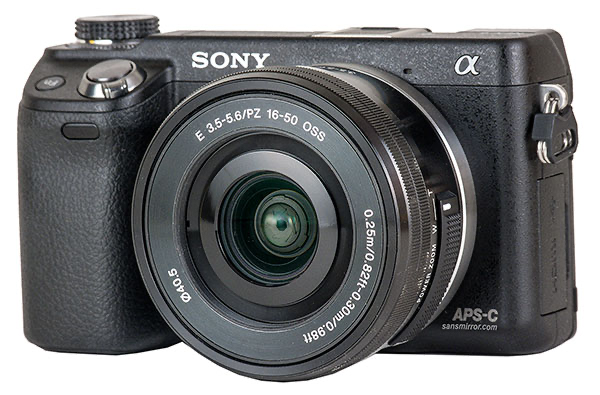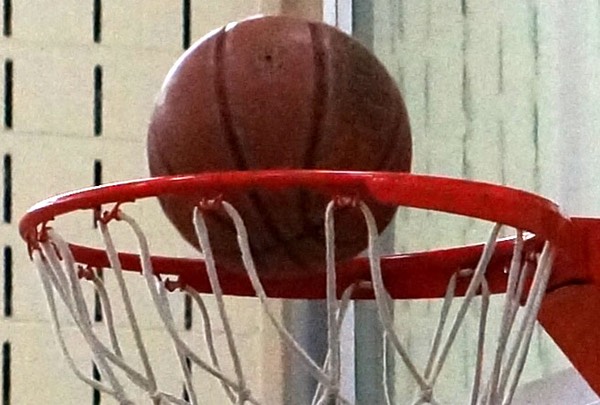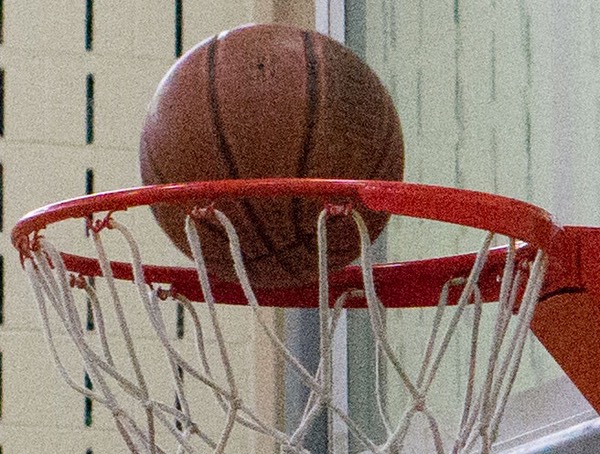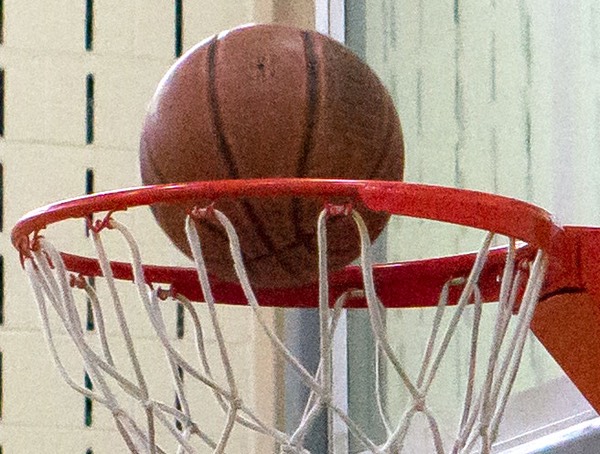
Sony NEX-6 with collapsing 16-50mm lens
What is It?
The fourth entry in Sony's model lineup—though third in its place in the growing line-up (3, 5, 6, 7)—the NEX-6 is an interesting mix. Basically take a Sony NEX-5R sensor and stick it in a Sony NEX-7 body, tweak a few things to bring costs down some more, add a few new features, and you have model that sits almost perfectly between the two donors.
That really does describe the NEX-6. It's clearly the NEX-7 body design, right down to the pop-up flash placement, the grip and shutter release, the tilting LCD, and much more. But there are differences. First, the NEX-6 gets a classic Mode dial ringed with a single command dial instead of the NEX-7's side-by-side command dials. Next, the 6 gets a lone AEL button instead of the switchable AF/MF and AEL button on the 7. The thumb rest is a bit shallower, and in the top plate of the 6 we find plastic (to allow for the WiFi antenna), but side by side, the cameras don't show a lot of meaningful physical differences.
Internally you will find significant differences. The NEX-6 is an updated 16mp sensor with phase detect focus sensors. The NEX-6 also gets built-in WiFi and a PlayMemories Application menu (in place of the Shoot Mode menu on the NEX-7 that's no longer necessary because of the Mode dial).
Compared to the NEX-5R, the NEX-6 offers two basic things: a better set of shooting controls (Fn button up top, command dial, Mode dial, etc.) and a built-in electronic viewfinder. Compared with the NEX-7, the NEX-6 takes away two basic things (the tri-dial configuration, and the 24mp sensor). Curiously, the rubber eye guard that comes with EVF on the NEX-7 was not present in my NEX-6 box; according to others it is included.
Like the NEX-7, the NEX-6 is made in Thailand.
For the full set of camera features, see the NEX-6 database page on this site.

NEX-6 on the left, NEX-7 on the right
How's it Handle?
The Mode dial makes a fairly dramatic change for some users. Since I shoot mostly aperture priority exposure mode, the primary thing that the Mode dial gives me is quick access to the panorama stitching mode and the Green all-auto mode if I hand the camera to someone else to take a quick snapshot of me. Still, it's nice to have it there. I use Manual exposure mode more on the NEX-6 than I did with the NEX-7 because of the ease of access, for example.

NEX-6 on left (note Mode dial), NEX-7 on right (note dual command dials)
The command dial around the Mode dial is very nicely implemented. The knurled edge makes it easy to find and turn, but the "click stops" in the rotation are easy to manage as you move through options when setting things. The NEX-6 dial is easier to find and turns a bit more firmly than the NEX-7 dials. Not a big thing, but very much a minor step forward, in my opinion. The NEX-7 dials are hard to move with light gloves on, the NEX-6 doesn't have that problem.
My sample has a pop-up flash that is a bit recalcitrant: I have to push in the flash button more than I can with mere flesh to get the flash to pop up (e.g. I have to use a nail or a tool). Not a big thing, but a step backwards from the ease of which this happens with my NEX-7.
One other change from the 7: the record video button has been moved from a position where you might accidentally trigger it to one that is decidedly difficult to mis-trigger (you can also turn the button off in the menus). It does seem as if Sony is hearing common user complaints and trying to address them as they update the models.

NEX-6 on left, NEX-7 on right
The menus, however, are getting longer and more difficult to navigate, though. All the WiFi-related things added to the Camera menu don't help, but being able to set 26 different things to the AEL button while only showing five at a time in the menu doesn't help things, at all. I do like the way the FN button works, though: you actually assign five different things to it. Press the button and the first of your choices is instantaneously available (command dial is used to change values), but you can use the Direction pad to move quickly to one of the other four. It's basically a Quick Menu of sorts, and appreciated. As with a lot of cameras these days, though, you really need to think about your customization of the various settable buttons, and in the case of the FN button, you really need to think about the order in which the items appear if you're trying to optimize how quickly you can set things.
The NEX menus, therefore, are both a blessing and a curse. There's a lot of meat in there, but you have to chew through a lot of gristle to find the best parts. Moreover, you must really think through how you customize your NEX-6. It took me a couple of tries to get it optimized right for my shooting needs. This is a good place to point out that the NEX-6 is a great backup to the NEX-7. With the exception of the change of dials up top, it's an easy move from one camera to the other. But that assumes one thing: that you've paid careful attention to your customization and have matched the cameras well. For example, the NEX-6 has ISO assigned to the right side of the Direction pad, while the NEX-7 assigned White Balance to that by default. You'll need to spend a bit of time re-aligning things so that both cameras function identically, but once done, moving back and forth between the two was pretty much a non-issue for me during testing.
The NEX-6 is a little slow to enter the WiFi access and PlayMemories information from the camera, as you're going to be using the Direction pad to move around a virtual keyboard to enter things (gee, maybe I shouldn't have picked such a long password for my office WiFi ;~). You also need a Sony Entertainment Network account, and we all remember how well customer security has been handled with the Playstation accounts (as in: not so good). But if you're familiar with the Apple Store on an iPhone or iPad, Sony seems to be trying to mimic this on the NEX-6 (and other cameras that use the PlayMemories concept). My problem is that the actual applications so far are either things that should have shipped with the camera, or relatively trivial. Sony has yet to show that this will turn into anything meaningful.
Overall, the NEX-6 handles pretty much like a NEX-7, but with one command dial instead of two, and a Mode dial instead of menu selection of exposure modes. That's a fair tradeoff, in my opinion.
One last thing: the density of the NEX-6 is somewhat pronounced. While it is a very small camera, it also feels a bit on the hefty side for its visual size. Personally, I like mass: it helps stabilize the camera during shooting.
How's it Perform?
Battery: as long as WiFi is turned off, the NP-FW50 battery is pretty much the same performer as it is on the NEX-7, basically about the 350 shot CIPA figure that Sony quotes in the manual. I've actually learned how to get a bit more than that by being discrete about using the EVF; the number is neither poor nor exceptional for a mirrorless camera. If you're a heavy EVF and/or WiFi user (or are using some of the PlayMemories apps, like the Timelapse application), then you're going to want to carry a couple of extra batteries around with you.
Autofocus: I have some good news and some not so good news. The good news is that the phase detect autofocus system is pretty decent, especially if there's plenty of light available. It was good enough to get in-focus basketball action shots in my gym, for instance. This is the closest any camera has come to matching the Nikon 1 phase detect, but it's still not quite up to the Nikon levels, especially with fast moving subjects.
As for the not so good news: in the default focus setting (especially when just using the contrast based system) there's a slight tendency for the focus system to do a out/in focus surge to confirm focus in low light. This shows in the EVF as going further out of focus and back into focus just before focus is achieved. Still, it's a very fast out/in surge, so it's more visually annoying than functionally annoying. The speed of the surge is a little dependent on the lens, too. I'm describing my experience mostly with the 16-50mm; the 55-200mm is not quite as punchy on the final focus surge, the faster primes don't tend to exhibit the trait.
Still, this is a fairly usable action focus system, as my basketball shooting revealed. But don't think it's going to solve your continuous action shooting problems. That's because the Sony is still using a mechanical shutter, and that means that the focus system isn't receiving information all the time as it can be with the Nikon 1 (in electronic shutter mode). There's some blackout time on the focus system (and EVF), which means shooting continuous action with continuous autofocus is still a bit of a problem. Better than any previous NEX model, for sure, and better than any of the m4/3 models for continuous shooting, but still not DSLR level.
In very low light or with non-contrasty subjects, the focus system still struggles and searches more. ISO 6400 and f/3.5 at 1/100 seems to be about a good breaking point for where I see a difference in focus performance. Down to that light level and the focus is snappy, below that and the focus system will sometimes do a bit of that in/out hunt before settling on the subject.
Overall, focus is one thing that is a step forward in performance from the NEX-7 to the NEX-6. We can all guess that the NEX-7 will get phase detect focus soon, too.
Write speed: Like the NEX-7, not wicked fast nor overly slow. With RAW+JPEG I am getting 12 shots before the buffer fills and the card slows down, about the same performance as with the NEX-7, surprisingly. Also like the NEX-7, the NEX-6 clears buffer space relatively quickly with a state-of-the-art card, enough so that you don't really feel buffer restricted except when you're shooting continuous action.
Image quality: At the lower ISO values, the Sony 16mp sensor and BIONZ processing is decent. I really have no problems with image quality at base ISO up to ISO 1600.
The JPEG created by the camera is a mess at higher ISOs, though (ISO 3200+). Let's look at what happens when you're playing above the camera's capabilities. The following shot is ISO 3200, underexposed by a half stop (so ISO 4500 or so equivalent). I'm pushing the NEX-6 a bit more than I usually do in these tests because ISO 3200 well exposed really should be considered a break over point for image quality. Once we move even a little past that the camera starts to struggle, as in this JPEG:

Lots of detail loss (look at the netting), noise reduction mottling (look at right wall), really bad contrast buildup and color change, and more. Sony really needs to up their game on the BIONZ processing when noise is present, as it's really clear to me that Nikon is getting better high ISO results from the very same sensors as is Sony. That's embarrassing.
Here's the raw version of the same image with no corrections (okay, minimal, basically Adobe default):

Not particularly great, all things considered. There's a lot of noise, though it's only just starting to show colored noise, a better performance than the NEX-7 gives at the same settings. I should point out that the NEX-6 was consistently trying to underexpose the shot. Normally I just shoot at ISO 3200 and everything's fine, but I kept having to reshoot with exposure compensation because the meter kept overreacting to highlight information (light colored walls, mostly). As I noted above, we're probably about a half stop down in exposure here, and that was enough to show me that I was pushing the camera too far. A few tweaks in ACR gives us this:

Still a little noisy, though the noise is more grain-like than anything else. There's also a bit of contrast build-up that's impossible to remove, but overall, the results are much more usable than the JPEG, and a lot of detail is still being preserved, even with the noise that's still present. I can process more of the noise out of the image, but not without losing some of the detail.
I would say be very careful about underexposing at high ISO values, and you'll want to shoot raw to get the best results in extreme conditions like this. ISO 3200 is quite usable as long as you don't underexpose, but if you do, it may be marginal, as the above results show.
For those making the NEX-6 versus NEX-7 decision, one thing to note about the high ISO characteristics is this: the NEX-7 throws in considerable color noise at matching ISO values that the NEX-6 doesn't produce. While the noise looks strong in the above images, it's not a digital giveaway in terms of noise like the false color noises of the NEX-7 at the same ISO.
Final Words
The NEX-6 shows a lot of the continued work that Sony has put into the NEX line. They continue to tweak and try to find the right UI, they keep extending capabilities (and unfortunately menus), they've tweaked things so that you can generally customize the camera so often used shooting controls are convenient (after you've completed the customization to your needs), and they've managed now to combine the best attributes of the NEX-5 (price, sensor) with those of the NEX-7 (EVF, control).
I know a lot of folk reading this are fans of the triple dial interface of the NEX-7. Frankly, I like the NEX-6's approach better. I'm sure there will be people lining up behind both those approaches (two dial versus three dial), but I think that's probably cutting the hairs too thin: both are very usable, and you'll adapt to either quickly, I think.
So we're really at the point where it comes to this: 16mp sensor for US$850 (body only) or 24mp sensor for US$1000 (body only). If you value WiFi or believe that Sony will ever get around to developing useful applications, then you award a bonus point or two to the NEX-6, but I think most people are going to decide on sensor size versus price. Simple answer: there aren't enough strong, fast lenses to justify the 24mp sensor at the moment. Basically the expensive Zeiss 24mm f/1.8, the 35mm f/1.8, and the 50mm f/1.8 (the 30mm f/3.5 macro also is quite good, but that's more of a speciality lens), plus the two Sigma lenses (19mm and 30mm f/2.8). So if you like primes, the NEX-7 will look better to you in terms of image quality. But if you like zooms, especially the kit zooms (18-55mm, or the new 16-50mm), the optics are better matched to the 16mp NEX-6, I think. Indeed, the NEX-6 with the collapsing 16-50mm is a pretty darned good jacket pocket camera.
Things will change later in 2013, though, with the arrival of new lenses from Sony, Zeiss, and others, so you also have to think forward, too. A NEX-6 maxes out at about 16" when printing at 300 dpi, the NEX-7 gets you to 20". Not a big difference (a 22% increase in linear resolution from the NEX-6 to the NEX-7), but a difference that would be meaningful to some. The question is whether that difference is currently worth US$150. Personally, no. I'd rather have the phase detect focus and the WiFi.
Indeed, of the four NEX models that have been through the sansmirror offices, the NEX-6 is the one that I'm most fond of overall. It's a very nice mix of features and performance in a small package. Of course, at the rate Sony has been iterating the NEX models, every few months we have another step forward. I expect the next NEX-7 will get the phase detection, WiFi, and applications, plus maybe another step or two forward, so it's possible that my answer would be different then.
One final comment: diffraction. If you're shooting at f/5.6 or faster, don't worry about it on a NEX-6, and you really don't have to worry about it on a NEX-7, either (thus my comment about strong, fast lenses, above). If you're a real pixel peeper or you're printing large, there is a difference of about a stop between the 16mp and 24mp sensor in terms of visible diffraction impacts. They start showing up at f/8 on the 24mp sensor, about f/11 on the 16mp sensor. I've heard too many folk say that the NEX-7 is preferred for landscapes only to find they're shooting at f/16 or f/22 for depth of field. At f/22 and a 16" print, I'm not sure they'd be able to distinguish any real gain from 24mp over 16mp. There's always an improvement by sampling more, which is what more megapixels means, but the question is whether that improvement is tangibly visible and worth paying extra for. It probably is if you're not letting diffraction rob you of much of the gain. It probably isn't if you're into diffraction territory all the time.
2018: this model is out of production and no longer available new. But used copies can easily be found. Also look at a current model, which would be the A6100 or other A6xxx model.
Support this Site. Purchase your NEX-6 from the following advertiser:
